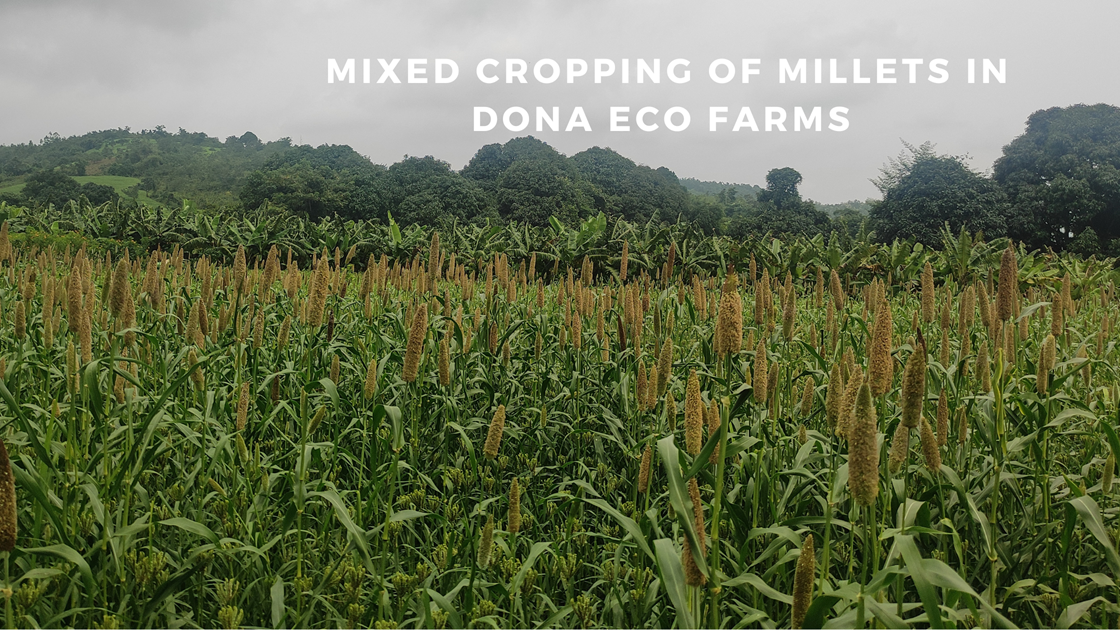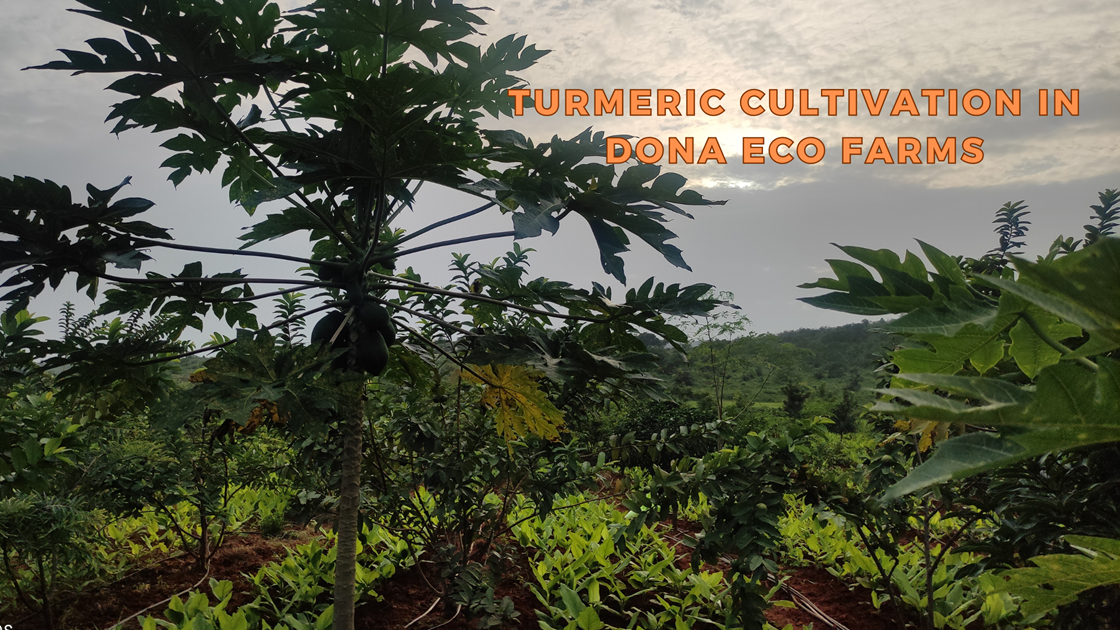At Dona Eco Farms, sustainability has always been the heart of everything we do. Over the years, our commitment to creating a harmonious balance between nature and agriculture has driven us to adopt innovative farming practices, one of which is mixed cropping of Millets. Among the various strategies we’ve employed, the mixed cropping system involving Finger Millet (Ragi) and Pearl Millet has proven to be one of the most effective and sustainable.
The Importance of Mixed Cropping of Millets:
Mixed cropping is an agricultural practice where two or more crops are grown together on the same piece of land. This practice not only enhances crop diversity but also maximizes resource use, improves soil health, and reduces pest and weed incidences. It is a traditional yet evolving technique that modern-day sustainable farms, like Dona Eco Farms, are embracing to increase yields and maintain ecological balance.
At Dona Eco Farms, we have found that combining Finger Millet (Eleusine coracana), one of the oldest cultivated crops in India, with bio-fortified Pearl Millet (Pennisetum glaucum) offers numerous benefits. Both crops are highly nutritious, drought-resistant, and well-suited to the semi-arid climate of our farm. Together, they make an ideal pair for mixed cropping, supporting the health of the soil and providing multiple sources of income.
Our Mixed Cropping System: Finger Millet and Pearl Millet
Here’s how we practice the mixed cropping system at Dona Eco Farms:
- Transplanting Finger Millet Seedlings: We begin by preparing the field for planting. Finger Millet requires careful handling, so we grow the seedlings separately in a nursery for about 20 days. Once the seedlings are ready, they are transplanted into the prepared field. Transplanting Finger Millet helps ensure stronger growth, better root development, and higher resilience to drought conditions.
- Broadcasting Pearl Millet Seeds: Immediately after the Finger Millet has been transplanted, we broadcast the seeds of bio-fortified Pearl Millet. This means scattering the seeds across the field so that they naturally integrate into the soil. Broadcasting allows Pearl Millet to establish itself without competing aggressively with Finger Millet, and it takes advantage of the spaces between the transplanted seedlings.
This dual cropping system is efficient in multiple ways. The wide spacing between the Finger Millet plants gives room for Pearl Millet to grow, and both crops utilize the soil nutrients in a complementary manner. Moreover, the Pearl Millet acts as a natural cover crop, reducing soil erosion and improving moisture retention.
Benefits of Mixed Cropping
1. Weed Suppression
One of the most noticeable benefits of this cropping system is the significant reduction in weed growth. Weeds can often outcompete crops for resources, particularly in monoculture systems. However, in our mixed cropping fields, the combination of Finger Millet and Pearl Millet naturally suppresses weeds. The Pearl Millet acts as a cover crop, shading the soil and preventing weed seeds from germinating. Additionally, the rapid growth of Pearl Millet ensures that weeds are starved of the sunlight and nutrients they need to thrive.
This reduction in weeds means less need for manual weeding or chemical herbicides, saving time, labor, and reducing environmental impact. The result is a cleaner, more productive field with less labor-intensive management.
2. Improved Soil Health
Mixed cropping enhances soil health through diverse root systems that penetrate different soil layers. Finger Millet and Pearl Millet have different root structures; Finger Millet has a fibrous root system that spreads out in the topsoil, while Pearl Millet has a deeper, taproot system. Together, these crops help aerate the soil, improve water infiltration, and enhance the soil’s ability to store nutrients.
The deep roots of Pearl Millet also bring up nutrients from the lower soil layers, making them available for the Finger Millet plants. This natural nutrient cycling reduces the need for synthetic fertilizers and supports long-term soil fertility.
3. Maximizing Yield
One of the primary goals of any farming system is to increase yields while minimizing inputs. In this mixed cropping system, we are able to harvest two crops from the same piece of land during a single growing season. The Finger Millet produces its grains, which are highly valued for their nutritional content, especially in the context of addressing malnutrition. At the same time, we are also harvesting Pearl Millet, an equally nutritious grain known for its high protein, fiber, and micronutrient content.
By growing two crops together, we are maximizing the productivity of our land and increasing the overall grain yield without requiring additional inputs like water, fertilizers, or labor.
4. Climate Resilience
Both Finger Millet and Pearl Millet are drought-resistant crops, making them ideal for cultivation in areas with unpredictable rainfall. By growing these crops together, we are further enhancing the climate resilience of our farm. In case of a dry spell, one crop may fare better than the other, ensuring that we still have a successful harvest. This resilience is crucial for small and medium-sized farms that cannot afford to lose an entire crop due to adverse weather conditions.
Moreover, growing a diverse range of crops is a key strategy for mitigating the risks associated with climate change. As weather patterns become more unpredictable, having multiple crops in the field reduces the chances of complete crop failure.
5. Additional Income from Pearl Millet
The inclusion of bio-fortified Pearl Millet in our mixed cropping system has provided us with an additional source of income. This is particularly important for smallholder farmers who often rely on a single crop for their livelihood. By diversifying our crops, we are able to increase our income streams and reduce our financial risk.
Bio-fortified Pearl Millet is also in high demand due to its nutritional benefits, especially in regions where micronutrient deficiencies are prevalent. Its high iron and zinc content make it a valuable crop for both local markets and export.
Recent Post: The Journey of Dona Eco Farms: From Barren Land to Lush Green Paradise
Lessons for Farmers: Improving Income Through Sustainable Practices
At Dona Eco Farms, we believe that sustainable practices like mixed cropping are key to improving the income and livelihoods of farmers. This system is not only ecologically sustainable but also economically viable. By reducing input costs, such as herbicides and fertilizers, while increasing yields and resilience, farmers can significantly improve their profit margins.
Moreover, mixed cropping offers farmers a way to diversify their income sources. Instead of relying on a single crop, farmers can grow two or more crops simultaneously, reducing the financial risks associated with market fluctuations, pest outbreaks, or crop failures. This kind of farming practice is particularly important in regions prone to droughts, where food security is a major concern.
Looking Ahead: The Future of Mixed Cropping at Dona Eco Farms
As we continue to refine and develop our farming techniques at Dona Eco Farms, we are excited about the potential of mixed cropping to create a more sustainable, resilient, and profitable agricultural system. Our experience with growing Finger Millet and Pearl Millet together has shown us that this method not only works but thrives.
We hope that our efforts in promoting sustainable farming will inspire other farmers to adopt similar practices. By sharing our journey and the success of our mixed cropping system, we believe that we can contribute to the broader movement of sustainable agriculture and help build a future where farming is both profitable and ecologically responsible.
In conclusion, the mixed cropping of Finger Millet and Pearl Millet at Dona Eco Farms is a step towards building a farming system that is resilient, productive, and sustainable. It has the potential to improve the income of farmers, reduce environmental impact, and contribute to a healthier planet. We encourage farmers everywhere to explore this system and adapt it to their own farms, creating a future where agriculture supports both people and the planet.




